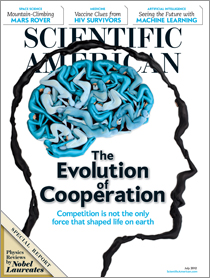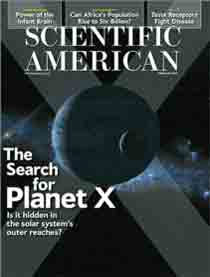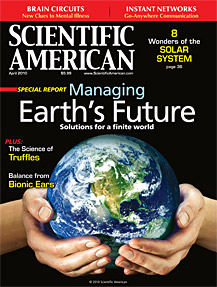Can a brain’s connectome be preserved forever?
The soul is the pattern of information that represents you—your thoughts, memories and personality—your self. There is no scientific evidence that something like soul stuff exists beyond the brain’s own hardwiring, so I was curious to visit the laboratories of 21st Century Medicine in Fontana, Calif., to see for myself an attempt to preserve a brain’s connectome—the comprehensive diagram of all neural synaptic connections.
This medical research company specializes in the cryopreservation of human organs and tissues using cryoprotectants (antifreeze). In 2009, for example, the facility’s chief research scientist Gregory M. Fahy published a paper in the peer-reviewed journal Organogenesis, documenting how his team successfully transplanted a rewarmed rabbit kidney after it had been cryoprotected and frozen to -135 degrees Celsius through the process of vitrification, “in which the liquids in a living system are converted into the glassy state at low temperatures.”
Can brains be so preserved? Fahy and his colleague Robert L. McIntyre are now developing techniques that they hope will win the Brain Preservation Technology Prize, the brainchild of neuroscientist Kenneth Hayworth (I’m on their advisory board as the advocatus diaboli). As I write this, the prize is currently valued at more than $106,000; the first 25 percent of the award will be for the complete preservation of the synaptic structure of a whole mouse brain, and the other 75 percent will go to the first team “to successfully preserve a whole large animal brain in a manner that could also be adopted for humans in a hospital or hospice setting immediately upon clinical death.” (continue reading…)
read or write comments (16)
The death of the brain means subjective experiences
are neurochemistry

“WHERE IS THE EXPERIENCE OF RED IN YOUR BRAIN?” The question was put to me by Deepak Chopra at his Sages and Scientists Symposium in Carlsbad, Calif., on March 3. A posse of presenters argued that the lack of a complete theory by neuroscientists regarding how neural activity translates into conscious experiences (such as “redness”) means that a physicalist approach is inadequate or wrong. “The idea that subjective experience is a result of electrochemical activity remains a hypothesis,” Chop ra elaborated in an e-mail. “It is as much of a speculation as the idea that consciousness is fundamental and that it causes brain activity and creates the properties and objects of the material world.” “Where is Aunt Millie’s mind when her brain dies of Alzheimer’s?” I countered to Chopra. “Aunt Millie was an impermanent pattern of behavior of the universe and returned to the potential she emerged from,” Chopra rejoined. “In the philosophic framework of Eastern traditions, ego identity is an illusion and the goal of enlightenment is to transcend to a more universal non local, nonmaterial identity.” (continue reading…)
read or write comments (14)
This review of The Brain and the Meaning of Life by Paul Thagard (Princeton University Press, Princeton, NJ, 2010. ISBN 9780691142722) appeared in Science Vol. 328, Issue 5979 in May 2010.
Twice I have spoken at the TED (Technology, Entertainment, Design) conference. Twice I have begrudgingly agreed to the strictly enforced 18-minute talk format—grumbling that “ideas worth spreading” (the TED motto) could not possibly be conveyed in such a constrained format. And twice have I been proven wrong. With discipline and diligence you really can say something of substance in a tight space, and more than 200 million downloads of endlessly entertaining and educational videos prove the principle of pithiness. (continue reading…)
Comments Off on Meaning-Making Neurons
How the brain produces the sense of someone present when no one is there
In the 1922 poem The Waste Land, T. S. Eliot writes, cryptically: Who is the third who always walks beside you? / When I count, there are only you and I together / But when I look ahead up the white road / There is always another one walking beside you.
In his footnotes to this verse, Eliot explained that the lines “were stimulated by the account of one of the Antarctic expeditions [Ernest Shackleton’s] … that the party of explorers, at the extremity of their strength, had the constant delusion that there was one more member than could actually be counted.”
Third man, angel, alien or deity — all are sensed presences, so I call this the sensed-presence effect. In his gripping book, The Third Man Factor (Penguin, 2009), John Geiger documents the effect in mountain climbers, solo sailors and ultraendurance athletes. He lists conditions associated with it: monotony, darkness, barren landscapes, isolation, cold, injury, dehydration, hunger, fatigue and fear. I would add sleep deprivation; I have repeatedly experienced its effects and witnessed it in others during the 3,000-mile nonstop transcontinental bicycle Race Across America. Four-time winner Jure Robic, a Slovenian soldier, recounted to the New York Times that during one race he engaged in combat a gaggle of mailboxes he was convinced were enemy troops; another year he found himself being chased by a “howling band” of black-bearded horsemen: “Mujahedeen, shooting at me. So I ride faster.” (continue reading…)
read or write comments (10)




